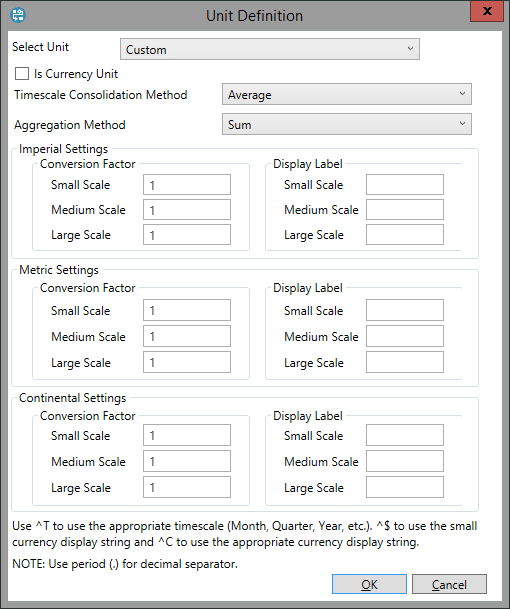Custom units of measurement
Dataflow has a wide range of pre-defined units of measurement; however, if the unit you need is not available, you can create custom units. To create a custom unit, open the Variables tab and click the cell in the Unit Type column. Click the arrow and the list of available units will be displayed. The Custom option is at the top of the list.

When you select the Custom option, the Unit Definition window will be displayed.

| Field | Description |
|---|---|
| Is Currency Unit | Indicates whether the unit is a monetary unit. |
| Timescale Consolidation Method | The method used to convert values into different periodicities. The available methods are: Sum, Sum - Time Weighted, Average, Average - Time Weighted, Last Period, First Period, Compounded, Equal Allocation Balance. |
| Aggregation Method | The calculation method used to consolidate values. The available methods are: Sum, Maximum, Minimum, Average, Weighted Average, Non-zero Average. |
Dataflow has three default unit systems: Imperial, Metric and Continental. The Imperial system is used as reference in all calculations. The Imperial Settings section contains factors for conversion between different scales. The Medium scale is the base and the other scales are defined against it.
The Display Label section contains labels for the unit at different scales. Planning Space uses the convention of 'M' for thousand and 'MM' for million, so, for example, the labels for oil volume are 'bbl', 'MSTB' and 'MMSTB'.
Note: There is a limit of 15 characters for the label strings. (This can be overridden if the Dataflow configuration is directly edited in the database, however the UI editor will truncate any labels longer than 15 characters.)
The image below shows conversion factors for a unit with different values for the three scales. Since the Medium scale is the base, 1 is set as the medium-scale conversion factor. One unit on the Medium scale contains 1000 individual units, thus the small-scale conversion factor is 1000. And one unit on the Large scale contains 1000 units on the Medium scale, thus the large-scale conversion factor is 0.001.

The image below shows an example of oil volume conversion from Imperial to Metric.

One thousand barrels is 0.1589873 m3, thus the conversion factor for the medium scale is 0.1589873. This conversion factor is multiplied by small- and large-scale factors (1000 and 0.001 respectively) to give the coefficients of 158.9873 and 0.0001589873. The labels for the unit are: m3, E3m3 and E6m3.
Note: Only simple multiplicative conversions can be used, i.e., you cannot set up conversions such as Celsius to Fahrenheit.
